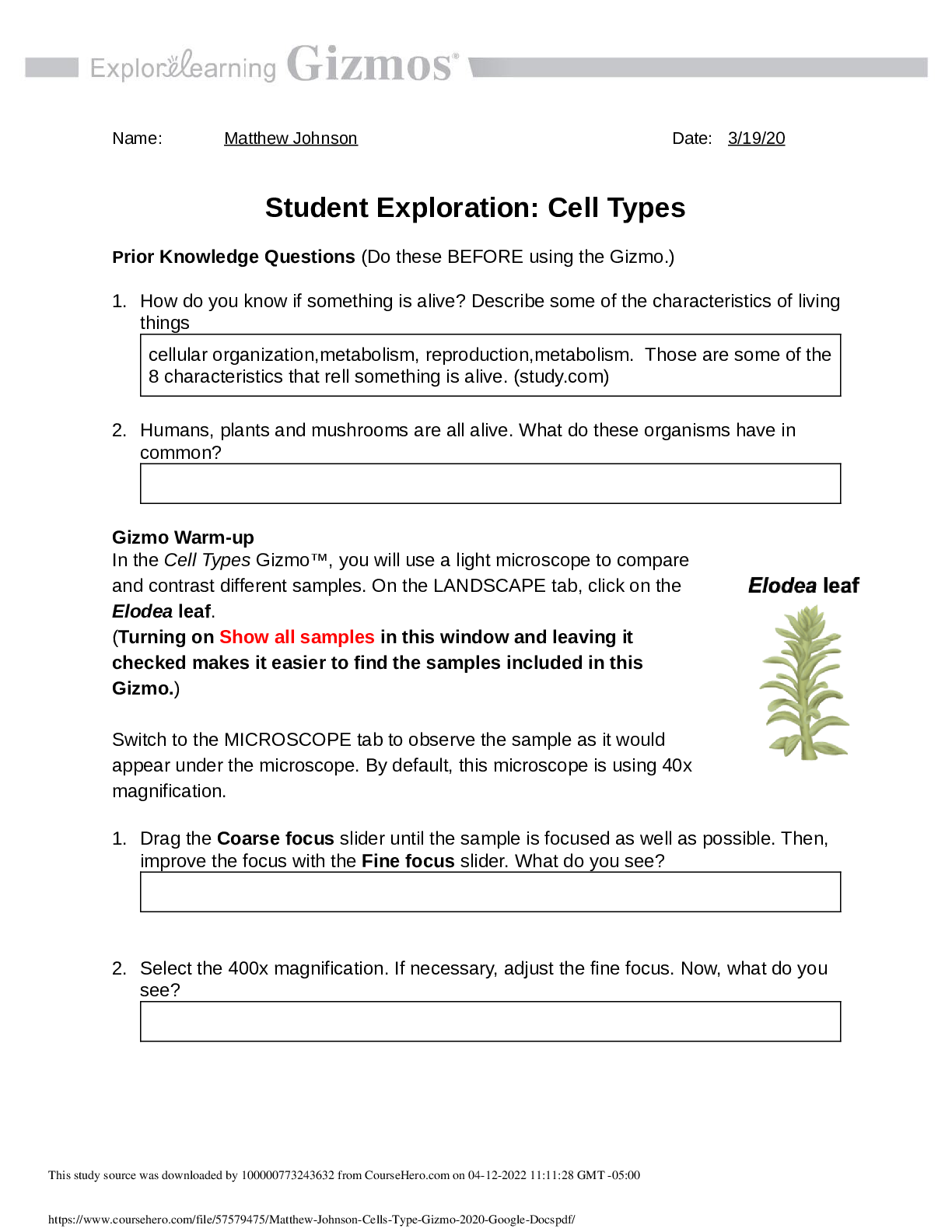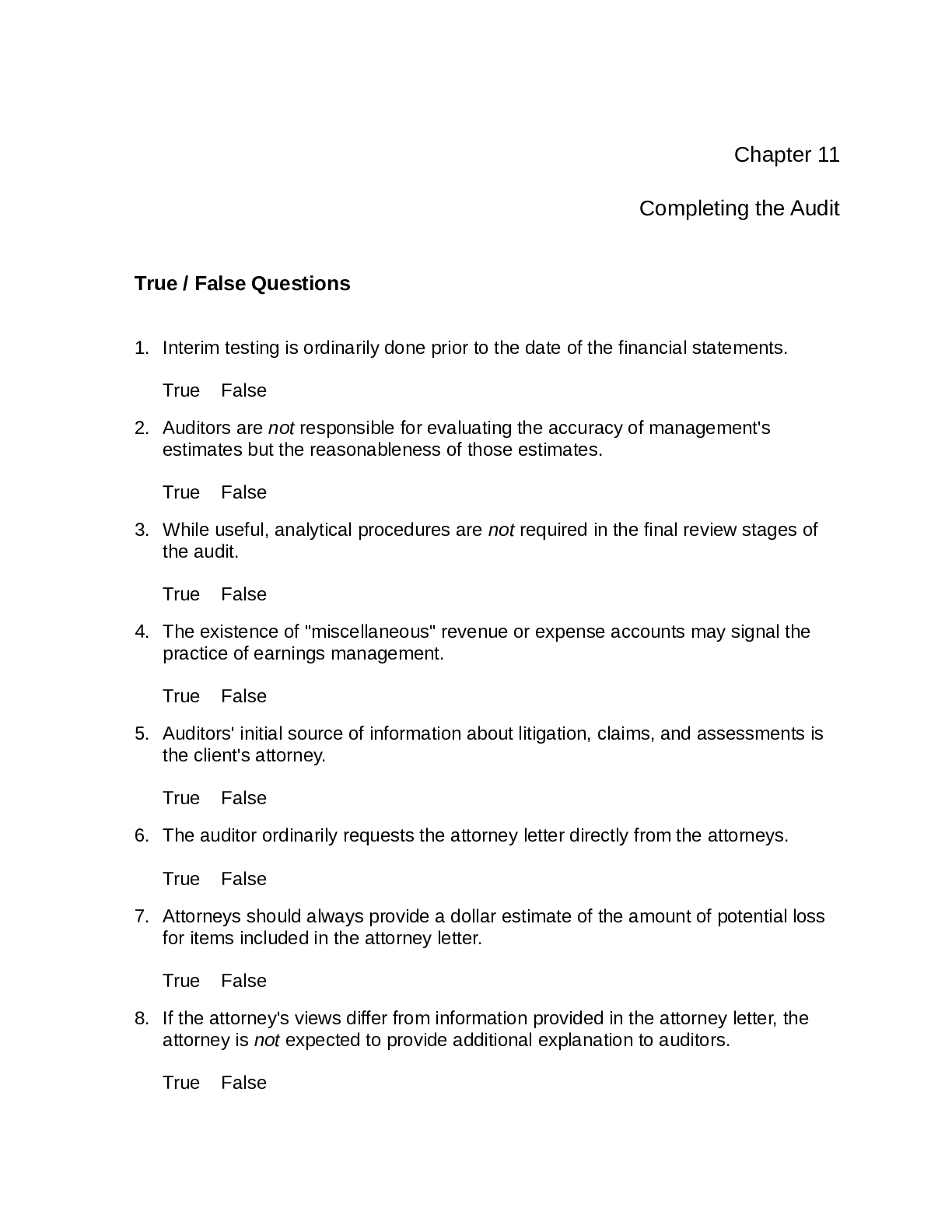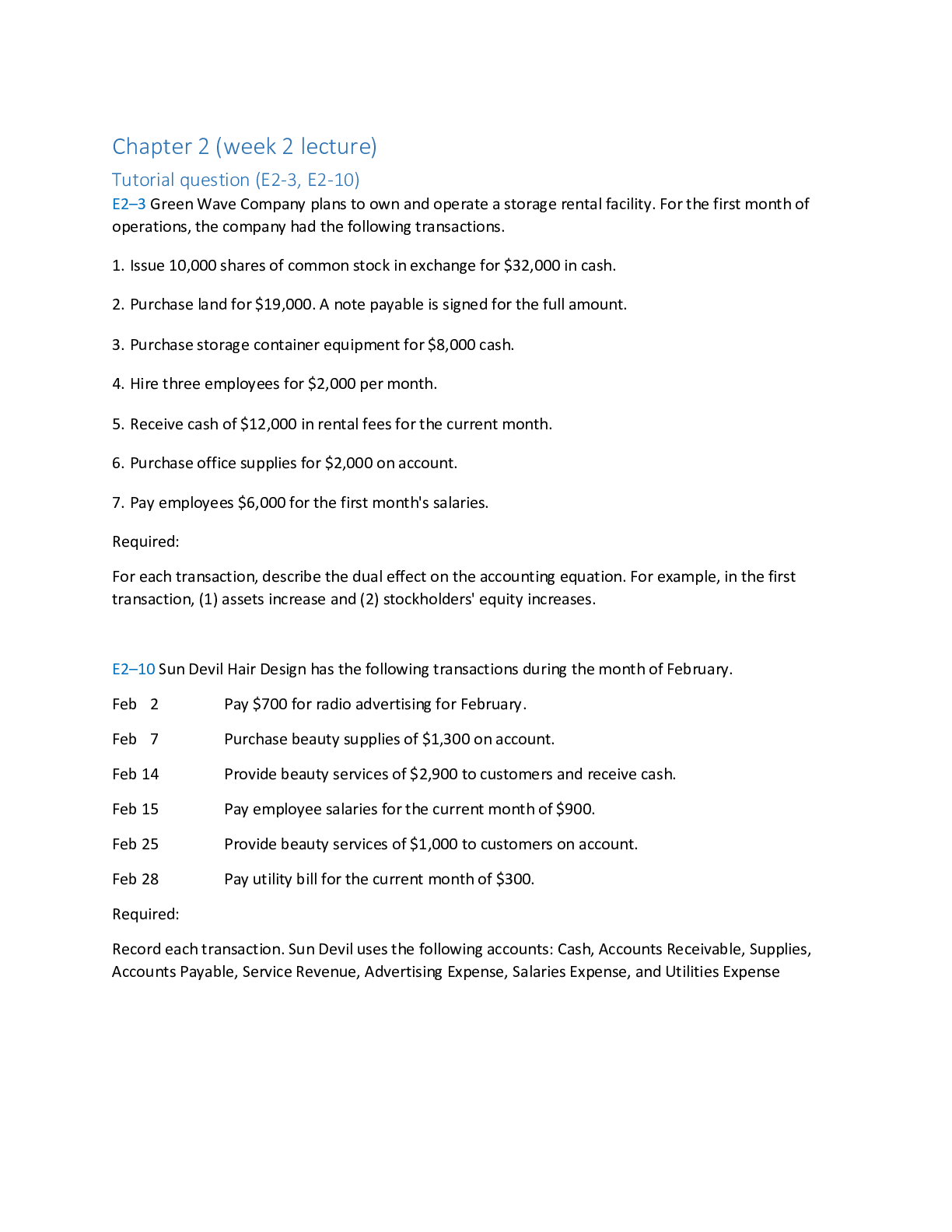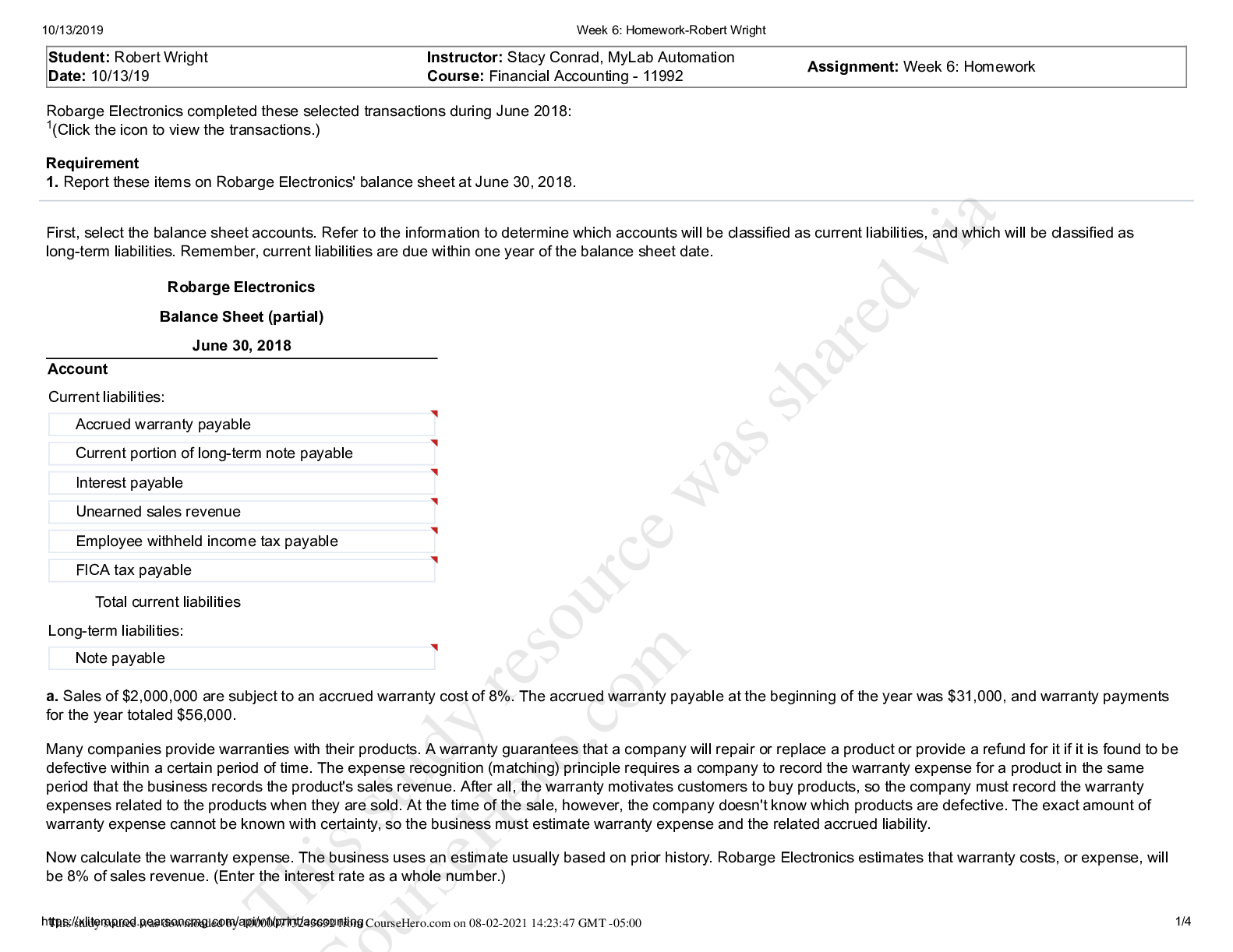Financial Accounting > QUESTION PAPER (QP) > ACCT 2110 Chap011. QUESTIONS BANK/ PRACTICE TESTS. RATED 5 STAR DOC (All)
ACCT 2110 Chap011. QUESTIONS BANK/ PRACTICE TESTS. RATED 5 STAR DOC
Document Content and Description Below
1. Which of the following events or activities normally occurs following the audit report release date? A. Interim testing. B. Roll-forward work. C. Subsequent events. D. Subsequent discovery of ... facts. 2. Interim testing normally occurs between the ____ and the ____. A. Beginning of the year under audit; audit report release date. B. End of the year under audit; audit report release date. C. Beginning of the year under audit; end of the year under audit. D. End of the year under audit; audit completion date. 3. Roll-forward work normally occurs between the ____ and the ____. A. Beginning of the year under audit; audit report release date. B. End of the year under audit; audit completion date. C. Beginning of the year under audit; end of the year under audit. D. End of the year under audit; audit completion date. 4. Which of the following substantive procedures are not extensively used in the audit of revenue and expense accounts? A. Analytical procedures. B. Detailed verification of cash receipts and cash disbursements records. C. Procedures conducted as part of the audit of related asset and liability accounts. D. Scanning accounts for large and unusual entries. 11-1 Chapter 11 - Completing the Audit 5. The substantive procedures for the examination of dividend and interest revenue would normally be coordinated with the audit of which of the following accounts? A. Receivables; investments. B. Receivables; fixed assets. C. Investments; fixed assets. D. Fixed assets; inventories. 6. The substantive procedures for the examination of cost of goods sold would normally be coordinated with which of the following audit plans? A. Cash disbursements. B. Inventory. C. Prepaid Expenses and accruals. D. Accounts payable. 7. Which of the following would not ordinarily be used as a benchmark when using analytical procedures to verify the overall reasonableness of revenue and expense accounts? A. Current-year recorded (unaudited) balances. B. Expected balances using a statistical analysis or relationships among accounts. C. Internal budgets and reports. D. Prior-year balances. 8. Why should auditors be particularly concerned with "miscellaneous", "other", and "clearing" accounts classified as revenues or expenses? A. These accounts are likely to relate to going-concern matters. B. These accounts are often more difficult to audit using normal substantive procedures. C. These accounts may represent attempts of "earnings management". D. These accounts are likely to require the assistance of a specialist. 9. Which of the following is the most effective method of identifying potential earnings management attempts? A. Analytical procedures. B. Detailed substantive procedures. C. Inquiry of client management and key financial personnel. D. Scanning accounts for unusual items. 11-2 Chapter 11 - Completing the Audit 10. An important method used by auditors to learn of material contingencies is A. Examining documents in the client's possession concerning contingencies. B. Inquiring and discussing them with management. C. Obtaining responses to an attorney letter. D. Confirming accounts receivable with the client's customers. 11. Which of the following procedures is not used in auditors' examination of litigation, claims, and assessments? A. Obtaining a description and evaluation of litigation, claims, and assessments from management. B. Examining documentary evidence regarding litigation, claims, and assessments. C. Reading minutes of meetings of stockholders, directors, and appropriate committees. D. Performing analytical procedures. 12. Which of the following is typically not included in the inquiry letter sent to the client's attorneys? A. A disclaimer regarding the likelihood of settlement of pending litigation. B. A listing of pending or threatened litigation, claims, or assessments. C. An evaluation of the likelihood of an unfavorable outcome. D. An estimate of the range of potential loss. 13. Which party should request a letter regarding litigation, claims, and assessments from the client's attorney? A. Attorney. B. Auditors. C. Client. D. Securities and Exchange Commission or other regulatory body. 14. To whom should management representations be addressed? A. Auditors. B. Board of directors. C. Client. D. Stockholders. 11-3 Chapter 11 - Completing the Audit 15. Which of the following items would appear in management's representations with no limitation due to overall materiality? A. Statements that a physical inventory was taken and inventory is properly valued. B. Information regarding all misstatements detected during the audit. C. Recommendations for improvements in the client's operations. D. The availability of all financial records and related data to auditors. 16. What is the primary purpose of obtaining management representations? A. To provide auditors with substantive evidence of important assertions. B. To impress upon management its primary responsibility for the financial statements. C. To allow auditors to communicate important internal control deficiencies to management. D. To allow auditors to communicate important suggestions for improvement to management. 17. If auditors are appointed on January 3, 2010, the balance sheet date is December 31, 2010, the audit completion date is February 7, 2011 and the audit report release date is March 3, 2011, what is the appropriate date of the management representations? A. January 3, 2010. B. December 31, 2010. C. February 7, 2011. D. March 3, 2011. 18. Which of the following reporting options is available if the client refuses to provide auditors with management representations? A. Unqualified or qualified opinion. B. Qualified or adverse opinion. C. Qualified opinion or disclaimer of opinion. D. Disclaimer of opinion or adverse opinion. 11-4 Chapter 11 - Completing the Audit 19. Why is it the client's decision to record adjustments to the financial statements? A. Having auditors adjust the financial statements would impair independence with respect to the client. B. The financial statements are the responsibility of the client's management. C. Auditors often do not have sufficient client-specific expertise to record adjustments to the financial statements. D. The client will ultimately suffer any losses related to misstated financial statements. 20. Which of the following is not a purpose of the review of audit documentation by a supervisor during field work? A. To ensure that all appropriate steps in the audit plan were performed. B. To ensure that referencing among audit documentation is clear. C. To ensure that the explanations included in the audit documentation are understandable. D. To ensure that the overall scope of the audit was appropriate. 21. Before the impact of adjusting entries proposed by auditors are included in the client's financial statements, the adjustments must be approved by the A. Client's management. B. Audit manager. C. Engagement partner. D. Engagement quality review partner. 22. Subsequent events occur between the ____ and the____. A. Balance sheet date; audit report release date. B. Audit completion date; report date. C. Balance sheet date; report date. D. Report date; beginning of subsequent year's audit. 23. Which of the following substantive procedures would not ordinarily be used by auditors in evaluating the potential existence of subsequent events? A. Reviewing the latest interim financial statements. B. Performing cut-off testing near year end. C. Inquiring of officers and other client executives. D. Obtaining management representations. 11-5 Chapter 11 - Completing the Audit 24. A subsequent event that provides additional information about a condition that existed at the balance sheet date is referred to as a(n): A. Revised disclosure. B. Subsequent discovery of facts. C. Type I subsequent event. D. Type II subsequent event. 25. A Type II subsequent event (requiring disclosure) would be illustrated by which of the following? A. Settlement of long outstanding litigation. B. Collection of a past due accounts receivable. C. Loss of inventory as a result of a flood. D. An additional tax assessment on prior income. 26. The Orange Corporation was audited for the year ended December 31 and the reports were delivered on February 15. After the audit completion date of January 25, auditors learned of a two-for-one stock split on February 1. If dual dating is used, what are the proper dates for the auditors' reports? A. December 31 and January 25. B. January 25 and February 1. C. January 25 and February 15. D. February I and February 15. 27. Auditors have a responsibility to evaluate whether financial statements properly reflect all subsequent events through the: A. Balance sheet date. B. Audit completion date. C. Audit report release date. D. Subsequent year's balance sheet date. 11-6 Chapter 11 - Completing the Audit 28. Management letters are not a means of A. Reporting recommendations to the client. B. Making the client aware of the firm's other services. C. Communicating matters related to the client's internal control. D. Developing rapport with the client. 29. An engagement quality review by a second partner of the audit documentation and financial statements is performed to ensure that the: A. "To-do lists" are reviewed and cleared. B. Audit plan procedures are "signed off." C. Tick-mark notations are cleared. D. Audit work meets the quality standards of the firm. 30. Auditors must complete various phases of an audit after the balance sheet date. This "subsequent period" extends from the balance sheet date to the A. Audit completion date. B. Final review of the audit documentation. C. Audit report release date. D. Delivery of the auditors' reports to the client. [Show More]
Last updated: 1 year ago
Preview 1 out of 89 pages
.png)
Buy this document to get the full access instantly
Instant Download Access after purchase
Add to cartInstant download
We Accept:

Reviews( 0 )
$10.00
Document information
Connected school, study & course
About the document
Uploaded On
Mar 19, 2022
Number of pages
89
Written in
Additional information
This document has been written for:
Uploaded
Mar 19, 2022
Downloads
0
Views
48


.png)






.png)
.png)

